Check out my custom vibration dampener
Tennis Grips
Types of Grips Explained & Illustrated
In the modern era, tennis grips have evolved along with changing equipment and court surfaces to help shape the progression of our sport.
Players are faster and stronger than ever, and their grips play a central role in controlling the extra power they can generate with topspin.
As a beginner, understanding why the shift in grips has occurred and the optimal grips to use will make you a better tennis player and enable you to compete at higher levels of the sport.
In this guide, we’ll explore the different types of grips for essential strokes in tennis, provide you with detailed explanations including advantages and disadvantages, and share pictures that illustrate them, so you know exactly how to form each grip.
Article Contents
Click below to jump to a section
Tap below to jump to a section
History of Grips
Types of Grips
Forehand
Backhand
Serves, Volleys, & More
How to Choose a Grip
Grips the Pros Use
Switching Grips
Wrapping Up
New to TennisCompanion?
Create a free account and explore my latest videos below
History of Tennis Grips
In the early days of the sport, the continental grip dominated.
Wooden racquets strung with natural gut strings were the norm, and up until 1974, three of the world’s biggest tournaments were played on grass, including Wimbledon, the Australian Open, and the US Open.
Grass courts are the fastest type of surface and produce a lower bounce than their synthetic and clay counterparts, which made the continental grip ideal for quickly scooping up balls that bounced well below the waist.
Wood racquets, on the other hand, were the gold standard through the 1970s, and their flexible frames and smaller head sizes didn’t offer much in the way of power. As a result, players were able to control the ball with quality technique and limited topspin, so the continental grip was sufficient.
Meanwhile, as the sport matured, it became more competitive, and players took their fitness regimes to a whole new level. The coinciding arrival of spin-friendly polyester tennis strings in the 1990s allowed players to swing faster and generate more spin, which controls power.
Ultimately, the combined shift away from grass courts as the dominant medium along with advancements in racquet and string technology led to innovation in the way players held their racquets.
First came the eastern forehand grip, which made generating topspin easier and ushered in a shift to more baseline play. Although it had been around since the 1920s, it wasn’t popular until Bjorn Borg’s success in the 1970s, which would help it become mainstream.
The semi-western grip picked up steam in the 80s with players like Andrea Agassi making use of the grip and playing almost exclusively from the baseline. Still, it wouldn’t stop there as players pushed the boundaries further with the western grip, and eventually, the rare Hawaiian grip.
Today, the continental grip still plays an integral role in the modern player’s repertoire, but more extreme grips that shift the player’s hand further under the racquet handle have replaced it for groundstrokes.
Different Types of Grips
Different types of shots in tennis require unique grips to maximize performance. In this guide, we’re going to cover:
- Forehand
- Slice forehand
- One-handed backhand
- Two-handed backhand
- Slice backhand
- Serve
- Volleys
- Overheads
However, before we dive into each, it’s important to understand how the shape of your racquet’s handle influences tennis grips.
More specifically, the handle of a tennis racquet is beveled, so instead of a perfect circle, it’s the shape of an octagon with eight sides, which we can label in a clockwise fashion for quick and easy reference.

The primary purpose of the bevels is to increase a player’s traction or, more specifically, prevent the racquet from twisting, but they also happen to serve as guides we can use to form different types of grips.
As we review each grip, we’ll share which bevel you should use to position the bottom knuckle of your index finger before wrapping your hand fully around the racquet’s handle.

Here’s a preview of how different grips require distinct positioning of your hand.

Independent of the different types of grips you use, it’s important to make sure you have the correct grip size, which can make it more or less challenging to achieve the proper grip and maintain control.
Helpful Tip
Keep in mind that while the bevels of a tennis racquet make for a great guide to help you get started, players often use slight modifications based on what feels comfortable to them. If you form a particular grip, we cover, but find making a small tweak by rotating the grip works better for you, then, by all means, change the grip to suit your needs.
Forehand Grips
The forehand is often the more natural groundstroke for players to learn and therefore has a tendency to become a player’s favorite shot.
Let’s take a look at the different types of forehand grips.
Continental Grip
As we covered in the history of tennis grips section, the continental grip dominated the early years of competitive tennis, but it has disappeared from the modern sport as far as forehands go.
Despite that, we like to share how to form it to give players context for how grips have evolved, but you’ll also use this grip for a handful of other shots as well cover later on.
Advantages
- Easy to handle low bouncing balls
- Little to no grip change required for other shots
Disadvantages
- Lack of topspin
- Lower power potential
- Difficulty handling high bouncing balls
How to Form a Continental Grip
To form the continental grip, place the palm side of your index finger’s bottom knuckle against the second bevel if you’re right-handed or the eighth bevel if you’re left-handed.
Then, position the butt of the racquet’s handle at the base of your palm and then wrap your fingers around the handle.

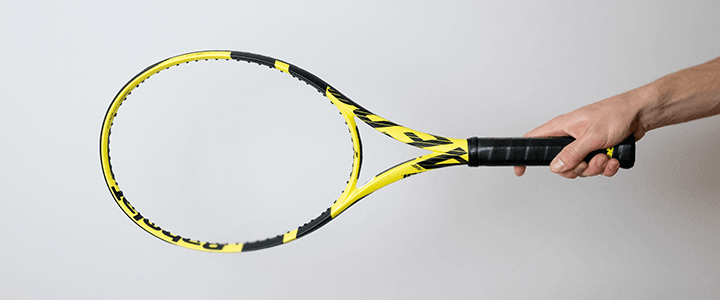

Eastern Grip
The eastern forehand grip perhaps reached the peak of its popularity during the late 80s and 90s, with Pete Sampras and Steffi Graf serving as excellent examples of players who used this grip to dominate.
These days, the eastern grip remains somewhat popular among tour and recreation players, but more often than not, players who appear to have an easter grip are using a slightly modified version.
Advantages
- Quick grip changes, ideal for serve and volley
- Sufficient topspin production
- Works well on faster court surfaces
- Easier for beginners to learn
Disadvantages
- Less topspin vs. western counterparts
- Difficulty handling higher bouncing balls
- Not ideal for aggressive baseline play
How to Form an Eastern Grip
To form the eastern grip, place the palm side of your index finger’s bottom knuckle against the third bevel if you’re right-handed or the seventh bevel if you’re left-handed.
Then, position the butt of the racquet’s handle at the base of your palm and wrap your fingers around the handle.
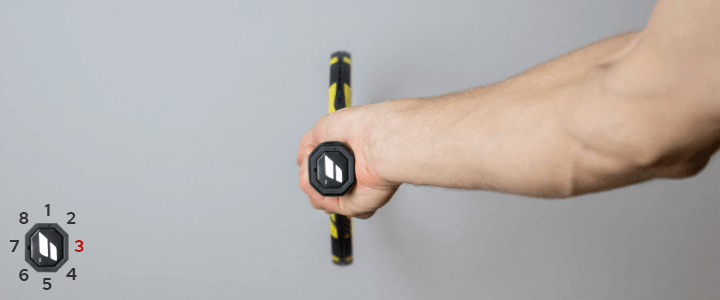


Semi-Western Grip
The semi-wester grip falls neatly between the eastern and western and has become the most common forehand tennis grip in modern tennis because it allows for excellent topspin and quick grip changes.
In the 90s and into the new millennium, players like Andre Agassi and Martina Hingis put the semi-western grip to work. However, these days it’s become the most prevalent grip that you’ll find used throughout the ranks, including top pros like Serena Williams and Novak Djokovic.
Advantages
- Excellent topspin
- Quick grip changes
- Ideal for baseline and all-court play
- Great defense against higher bouncing balls
- Works well on all court surfaces
Disadvantages
- Some difficulty with low balls or shots that cause players to stretch wide outside their strike zone
How to Form a Semi-Western Grip
To form the semi-western grip, place the palm side of your index finger’s bottom knuckle against the fourth bevel if you’re right-handed or the sixth bevel if you’re left-handed.
Then, position the butt of the racquet’s handle at the base of your palm and wrap your fingers around the handle.



Western Grip
The western grip is the last of the four primary forehand tennis grips, which falls a step beyond the semi-western and allows players to generate maximum topspin.
The western grip exists on the pro tour, and you’ll find plenty of amateur players using – especially players from Europe where clay is a popular court surface, such as Europe and Latin America. Clay makes for the slowest court surface, and the ball bounces higher, which the topspin of more extreme grips accentuate.
Although you’ll find a handful of tour-level players using, it tends to be a bit too extreme for many players. At the beginner level, it can be hard to fathom how to hit a forehand with this grip.
Advantages
- Maximum topspin
- Works well on slower court surfaces
- Ideal for baseline play
- Well-suited for high bouncing balls
Disadvantages
- Challenging to switch grips quickly
- Difficult for beginners to learn
- Hard to handle low balls or shots that cause players to stretch wide outside their strike zone
How to form a Western Grip
To form the western grip, place the palm side of your index finger’s bottom knuckle against the fifth bevel if you’re right-handed or left-handed – it’s the halfway point around the handle.
Then, position the butt of the racquet’s handle at the base of your palm and wrap your fingers around the handle.

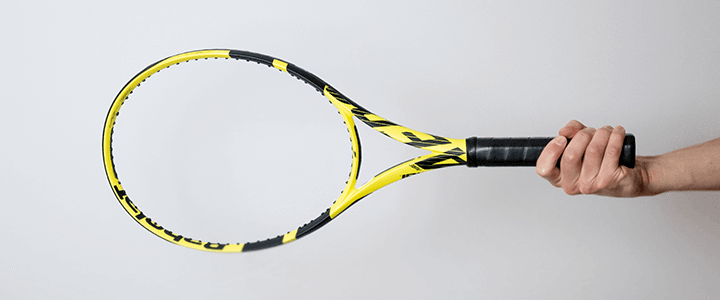

Hawaiian Grip
Last, and in this case least, the Hawaiian or extreme-western grip pops up periodically but has never seen widespread usage.
In essence, it has the drawbacks of the western grip but magnified. Plus, it can be difficult for players to flatten out and drive the ball, which adds another challenging layer to the equation.
Topspin is beneficial, but players need to be able to hit through their opponent periodically and put shots away to compete at higher levels of the sport.
Advantages
- High levels of topspin
Disadvantages
- Challenging to switch grips quickly
- Difficult for beginners to learn
- Increased likelihood of injury
- Tough to drive the ball and play offensively
- Hard to handle low balls or shots that cause players to stretch wide outside their strike zone
How to Form a Hawaiian Grip
To form the Hawaiian grip, place the palm side of your index finger’s bottom knuckle against the sixth bevel if you’re right-handed or fourth bevel if you’re left-handed.
Then, position the butt of the racquet’s handle at the base of your palm and wrap your fingers around the handle.
Which Forehand Grip is The Best?
Many would argue the semi-western is the best forehand grip and be quick to dismiss all other grips in its favor. However, doing so neglects the tendencies, comfort, and preferred playing styles of each player.
Therefore, players and coaches should be willing to experiment and find the grip that best aligns with the player as a whole, which may include a slight tweak or variation in many of the grips we’ve discussed.
With that said, we’d encourage new players to steer clear of the continental and Hawaiian forehand grips, which will prevent the vast majority fo players from reaching their full potential.
Players looking for an easy grip to start with should consider the eastern forehand grip. Once a player gets the hang of it, they can begin to experiment with the western grips to see what works best for them.
It’s also worth noting that many of the best tennis players don’t rely entirely on one specific grip, and they’ll make minor adjustments on the fly to achieve the desired effect, i.e., more topspin or a flatter shot.
Injuries
There has been some study of tennis injuries that have found what appears to be a correlation with the type of grip and likelihood of injury, such as the 2016 paper titled Wrist Injuries in Tennis Players: A Narrative Review.
However, while the study’s abstract seems to indicate an increase in total wrist injuries or as a percent of common injuries, it does not seem to be conclusive. Furthermore, the article seems to suggest that overuse and repetition may be the culprit, which the type of grip might amplify.
With that said, we’d encourage players to listen to their bodies, allow themselves sufficient rest and recovery when needed, and, most importantly, speak with their doctor if they’re experiencing pain or discomfort while using a specific type of grip.
Backhand Grips
For players to compete at the highest levels, it’s necessary to develop a reliable backhand and ideally make it a weapon. If it’s weak, a poor backhand can become an easy target that your opponents exploit.
Many players struggle with their backhand because it requires that you hit across your body, and historically it has been the weaker shot for most players.
However, these days a player’s backhand can be just as lethal and more reliable than a player’s forehand, and it all starts with finding the ideal grip.
When it comes to the backhand, there are two varieties: the two-handed and the one-handed, both of which are prevalent.
Two-Handed Backhand
It wasn’t until the 1970s when players like Bjorn Borg, Jimmy Connors, and Chris Evert burst onto the scene that the two-handed backhand started to emerge.
These days, the two-handed backhand is by far the most popular backhand across the sport. At the time of writing, 88% of the top 100 players on the men’s side use a two-handed backhand, and that number jumps to 97% on the women’s side.
Early on, when young children learn how to play tennis, they’re typically taught the two-handed backhand because they don’t have the strength and coordination to hit with one-hand on their backhand side.
However, older players who are learning the game often gravitate toward a two-handed backhand because the extra hand helps increase the player’s control of the racquet on the non-dominant side of their body.
Advantages
- Easier to learn
- Added control
- Extra power
Disadvantages
- Limits a player’s reach on shots that cause them to stretch wide outside their strike zone
How to Form a Two-Handed Backhand
To form the two-handed backhand, first form the continental grip with your dominant hand by placing the palm side of your index finger’s bottom knuckle against the second bevel if you’re right-handed or the eighth bevel if you’re left-handed.
Then, position the butt of the racquet’s handle at the base of your palm and wrap your fingers around the handle.

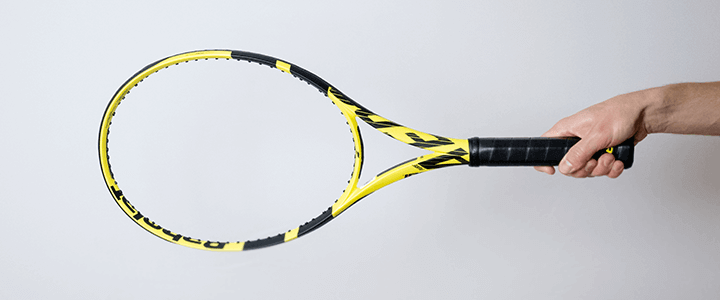

Next, take your non-dominant hand and place the palm side of your index finger’s bottom knuckle against the seventh bevel if you’re right-handed and the third bevel if you’re left-handed.
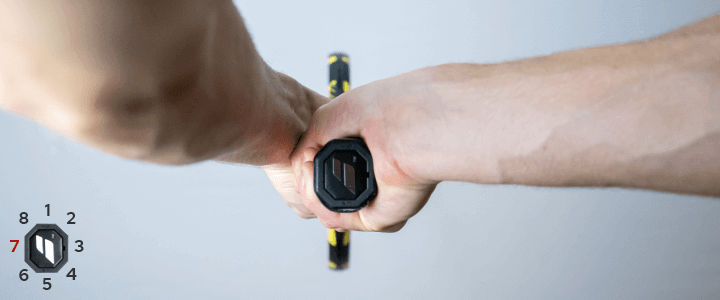


In effect, your dominant hand is using the continental grip, while your non-dominant hand is using the eastern grip.
One-Handed Backhand
Despite the popularity of the two-handed backhand, the one-handed topspin backhand is still alive and well with players on the ATP and WTA Tour using it. However, more players on the men’s side are competing at the highest levels with it.
Roger Federer, Dominic Thiem, Stan Wawrinka, Richard Gasquet, and Grigor Dimitrov are a few tour veterans that are well-known for their one-handed backhand and up-and-comers like Stefanos Tsitsipas and Denis Shapovalov also make use of it.
Currently, five of the top 20 men’s players use the one-handed backhand, but you won’t find a single player in the women’s top 50 using it.
Often, players will begin by learning a two-handed backhand and then experiment with a one-handed backhand once their skill level and coordination allows them to make the transition.
Advantages
- Slight added reach
- Superior angles in some situations
Disadvantages
- Steep learning curve for most
- Requires strength and coordination
- Difficulty returning serves
- Harder to handle high balls
- Challenging open stance execution
How to Form a One-Handed Backhand
To form the one-handed backhand grip, place the palm side of your index finger’s bottom knuckle against the first bevel if you’re right-handed or left-handed.
Next, make sure the handle of the racquet runs roughly parallel to the rest of the knuckles, minus the thumb. This step is where a lot of players go wrong with their one-handed backhand as it’s a small adjustment from how you’ll be used to holding your forehand.
Last but not least, position the butt of the racquet’s handle at the base of your palm and then wrap your fingers around the handle.
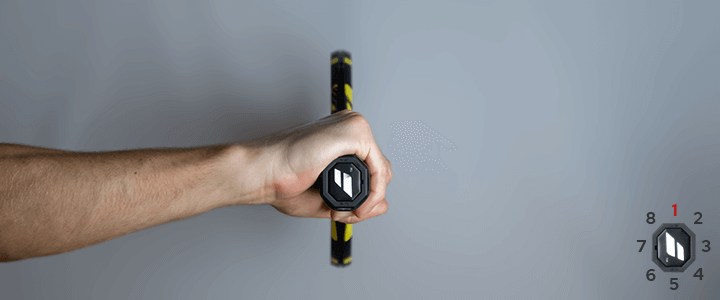
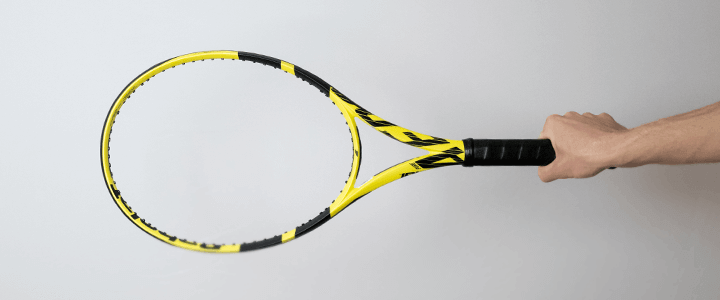

One-Handed Backhand Modifications
Although we recommend you use the first bevel of the racquet as a starting point to position your hand for the one-handed backhand, you may want to experiment with rotating the grip a bit further.
For example, some players will place their knuckle on the edge of the bevel that sits between bevel one and eight if you’re right-handed, and bevel one and two if you’re left-handed.
Doing so will close the racquet face slightly and offer up a bit more topspin potential, but it can be tricky for players initially.
Serve, Volley, Slice, Overhead Grip
Although the continental grip has fallen out of favor with the modern forehand, it’s still a versatile grip for a variety of other essential shots including:
- Serve
- Forehand volley
- Backhand volley
- Half volley
- Slice forehand
- Slice backhand
- Overhead
- Drop shot
That’s right, one grip for all these shots, and you don’t need to change the grip as you transition from one to another.
Moreover, it’s one of the few grips where players and coaches agree that it’s the ideal grip for all of these shots, and although it can be tweaked slightly, it’s not necessary.
When it comes to the serve, the continental grip unlocks various types of serves, including the flat, slice, and the topspin or kick serve. The grip, of course, works perfectly for the overhead too.
At the same time, the open racquet face complements volleys, slice groundstrokes, and the drop shot.
All in all, the continental grip remains critical to a player’s game, so it’s essential to understand the grip and how to form it.
Jump back to the continental grip section earlier in this guide for a refresher on how to form this grip.
How to Choose a Grip
When it comes to a player’s forehand and backhand, there are a few different grips worth evaluating. Ultimately, players and coaches should work together and be willing to experiment to find out what feels natural and performs best for their style of play.
Be wary of coaches or instructors who take a one-size-fits-all approach without considering the uniqueness of each player. Yes, some grips tend to work well for the majority of players, but it’s a shortsighted mindset.
Federer was once asked in an interview why he used the one-handed backhand instead of a two-handed backhand, and his response was pretty straightforward; it didn’t feel natural. Each player has a slightly different build, and those nuances are important to take into consideration.
For proof, pros like Federer and Nadal teach us that players can have dramatically different grips and still find success.
Recommended Starting Points
If you’re not sure where to start and you’re looking for some advice on grips to use, then here would be our recommendations:
- Forehand: Semi-western
- Backend: Two-handed
- Serve, volleys, slice, etc: Continental
Many players will find these grips work great, but it’s super easy to experiment, so don’t lock yourself into these as your only option.
Switching Grips
One of the factors that come into play with the different types of grips is how quickly you can change from one grip to another. This skill is particularly critical on a player’s return of serve where time is limited.
A player using the two-handed backhand should hold their forehand grip with their dominant hand but also hold the racquet handle with their non-dominant hand already on the correct bevel for their backhand.
Doing so allows a player to release their forehand grip and rotate the racquet quickly to find the continental grip so they can execute their backhand without also having to change the position of their non-dominant hand.
If you’re using a one-handed backhand, you might find it easier to hold the racquet at the throat with your non-dominant hand so that you can quickly rotate the handle to find the correct grip.
Grips the Pros Use
The different grips players use on the pro tour is a hotly debated topic with many differing opinions. In our view, the reason fans come to different conclusions is twofold.
First, many players don’t form a “textbook” grip in the sense that they place their knuckle exactly on a particular bevel. Many players to ride the edge of a bevel with their knuckle, which puts them between grips and makes it harder to decipher.
Second, players make small tweaks and adjustments to their grips on the fly without even thinking about it. Plus, during a grip change, a player might not set their grip perfectly, but that doesn’t mean they can’t still execute, so in some cases, the grip might look different.
With that said, here’s our take on the big three.
Helpful Tip
We’d encourage you to avoid using a player’s grip just because they’re on the pro tour. Again, what works for one player doesn’t always translate well for another, and some pros use unorthodox grips that aren’t ideal to emulate.
Roger Federer
On the forehand wing, Federer uses a modification of the eastern grip, but rotated slightly further, not quite halfway toward the semi-western. The grip suits his all-court style of play very well.
He also uses a one-handed backhand with an eastern grip. Although it’s his weaker side, which players like Nadal have exploited over the years, it’s still a weapon and has served him well throughout his career.
Rafael Nadal
Nadal has one of the most lethal forehands in the game, and his grip is often the topic of debate. If we had to pick one, we’d say he’s using a semi-western grip, but we don’t think it’s that cut and dry and believe it falls slightly between a semi-western and full-western.
We’d also argue that Nadal’s forehand grip has evolved a bit over the years and has become slightly less extreme than it used to be.
For Nadal’s two-handed backhand, he uses a continental grip for his dominant hand and a semi-western grip for his non-dominant hand, which is a modification of the typical eastern grip for the non-dominant hand.
Novak Djokovic
On the forehand side, Novak Djokovic uses a slightly modified semi-western grip, which, if you do enough digging online, you’ll hear some people refer to a 3/4 western. Regardless, we think it suffices to say it falls somewhere between the two.
For his two-handed backhand, Djokovic grips his dominant hand with a continental grip and his non-dominant hand with an eastern grip, which is typical of a two-handed backhand.
Wrapping Up
As a beginner, the different types of tennis grips are one of the first things you’ll learn. Your instructor may have some recommended grips to start with, and these will likely suit you well, but by expanding your knowledge of the different grips, you can experiment to find what’s right for you.
As we’ve covered, each grip has its pros and cons, so there’s not a single one-size-fits-all grip for all players.
If you have any questions, we’d love to hear from you in the comments below and feel free to share which grips you’re using too.
Play Better Tennis
Improve your game alongside our community of tennis players
Why join?
Discussion Boards
Join the conversation with other members of the community.
5 Point Friday
Read our weekly recap of the 5 most interesting things we dig up in tennis.



Leave a Reply
Want to join the discussion?Feel free to contribute!